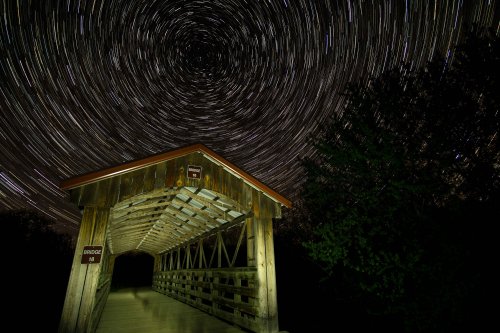Hello, Learning Outside Blog Readers! It has been a busy couple of months since we last posted here. Our posts about stargazing are always popular, and we hope you'll enjoy another fantastic post by astronomy educator, John Heasley, on the remarkable opportunity of the fall night skies.
On the first day of September, I had a wonderful time hiking the trails of Kickapoo Valley Reserve well beyond midnight. I was on a mission with my Unihedron Sky Quality Meter to measure just how dark it was at nine sites. And I was guiding and assisting an astrophotographer friend who was creating images to be part of the new dark sky exhibit there and for our application to the International Dark-Sky Association to be designated as an International Dark Sky Park.
During twilight, we were wowed to see the planets of our
solar system emerging. But as the skies darkened even more, we were awed by the
sight of our Milky Way emerging and bending across the heavens. It is something
I would love for you to see for yourself by walking in the dark this month.
You will want to pick a park or country road away from city and town lights. I love wandering and trying new paths but not at night. Pick a familiar trail that you’ve walked by daylight. Paved paths such as Old 131 are an excellent choice. Just park where it crosses CTH P and head south to Little Canada or north to the Ho Chunk Bridge. You can turn off your flashlight and not worry so much about uneven surfaces. If you need a little light, red or amber is best to give your eyes the best opportunity to adapt to the dark. Feel safe and have more fun by bringing along a companion or two. Maybe one of your geeky friends who can help you identify the birds you’re hearing as well as other sounds of the night world. One of us stayed the night at a campsite and the other drove home. Give a little thought to what is best for you. Campsites A, C, I, J, K, L, and PP are wonderful places to see the stars. If night hiking is not the best match for you, Landing 14 where CTH P crosses the Kickapoo is easy to find and has dark skies for you to take in the view.
Sunset is around 6:45pm at the start of October and around 6:00pm at the end. It’s a great time to experience twilight. The sky is fully dark about 75 minutes after sunset, so 8:15 on October 1st and 7:30 on Halloween. You can start even earlier in November, especially after November 7 when we let our clocks go back to natural time. New Moon is October 6, and you can see the Milky Way without moonlight interfering Oct 1-10 and Oct 23-31. A moonlight walk is also fun. Full Harvest Moon is September 20 and Full Hunter's Moon is October 19 and 20. You can be soothed by the soft glow of moonlight in the middle of the months.
Don’t forget to celebrate International
Observe the Moon Night on October 16 when humans across the globe
are encouraged to look up together and honor our connection with the Moon
through stories and images and art. That night, brilliant Venus will be near ruddy Antares in the western
sky while the waning gibbous moon, Jupiter, and Saturn will form a line across
the southern sky. But whenever or wherever, I hope you are as refreshed
as I was walking in the dark.
John Heasley is an
astronomy educator and stargazer who enjoys connecting people with the cosmos. He volunteers with NASA/JPL as a
Solar System Ambassador, with the IAU as a Dark Skies Ambassador, and with
International Dark-Sky Association as an Advocate. For more information
about stargazing in southwest WI, like Driftless Stargazing LLC on Facebook and find out whenever there's
something awesome happening in the skies.
































